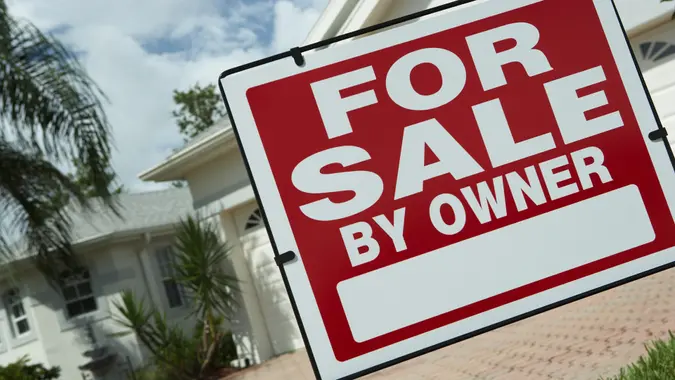How to Buy a House in 2025: 8 Simple Steps for First-Time Buyers

Commitment to Our Readers
GOBankingRates' editorial team is committed to bringing you unbiased reviews and information. We use data-driven methodologies to evaluate financial products and services - our reviews and ratings are not influenced by advertisers. You can read more about our editorial guidelines and our products and services review methodology.

20 Years
Helping You Live Richer

Reviewed
by Experts

Trusted by
Millions of Readers
If you’re considering buying a home this year, you can look forward to starting 2026 with a place to call your own, which doubles as your most valuable asset and your best chance at building long-term wealth.
However, getting there is a long, complex and expensive process. That process can be broken down into the following eight steps.
Step 1: Understand Your Finances
First, assess your current financial situation.
- Review your credit score: Your score will determine whether you can get a mortgage and at what interest rate. According to Experian, 620 is the bare minimum needed for a conventional loan, but higher is always better.
- Assess your savings: You shouldn’t start saving for a home until you’ve built an emergency fund to cover at least a few months’ worth of expenses.
- Consider your monthly budget: The price of the property is just one expense to prepare for. Calculate all costs, including your mortgage, mortgage insurance, if applicable, homeowner’s insurance, taxes and utilities.
- Other costs to consider: You’ll also have to factor in expenses like maintenance and repairs, which are typically 1% to 2% of the home’s value per year.
Step 2: Save for a Down Payment
Next, put as much money in the bank as you can.
- Low-down-payment options: Before you set your savings target and timeline, see if you qualify for FHA loans, USDA loans, 3% down programs and other alternatives to the traditional 20% standard.
- Down payment assistance programs: Use a resource like the Fannie Mae Down Payment Assistance Tool to find government programs that can help you get started, or ask your company about employer-sponsored programs.
- Saving strategies: Create a dedicated savings bucket for your down payment and contribute to it consistently — but not at the expense of an emergency fund. Enable automatic contributions and use your bank’s app to track and monitor your progress.
Step 3: Get Pre-Approved for a Mortgage
Third, see how much you qualify to borrow.
- Understanding pre-approval: Preapproval is a letter that a lender issues after vetting your income, credit and other financials. Obtaining one is essential to establish your price range and show sellers that you’re serious.
- Choose the right type of loan: Learn about the different kinds of loans and decide which is right for you. For example, most loans are conventional mortgages, which typically cost less but are harder to get than FHA loans, which are open to those with less money down and lower credit scores. Other options include VA loans and USDA loans.
- Debt-to-income ratio: When researching, keep your all-important debt-to-income ratio in mind. Lenders like to see that you’re managing debt well, that you’re not borrowing above your means and that you’ll be able to keep up with your mortgage payments — debt totaling no more than 36% of your income will get you the best rates.
To make sure you’re fully prepared for the home-buying process, it’s important to understand the steps involved. Learn more about how to buy a house and ensure you’re making informed decisions every step of the way.
Step 4: Find a Real Estate Agent
Enlisting the help of the right professional might be the most important step of all.
- Why work with an agent?: A real estate agent can save you time and money while helping you choose the right property.
- How agents can help: Their experience, expertise and knowledge of the local market can prove invaluable — and a good agent will advocate and negotiate on your behalf, manage your paperwork and anticipate problems before they arise.
- Choosing the right agent: Get referrals from family and friends, interview multiple agents and scour reviews from multiple sources. Most importantly, choose an agent who specializes in the specific area you’re searching — the more hyper-local your agent’s knowledge, the better.
Step 5: Choose the Right House
Finding the right home in the right neighborhood can determine the course of your entire life.
- Location considerations: Cost, of course, is a factor — but it’s not the only factor. Cities, suburbs and rural areas all have different pros and cons, and factors like crime, walkability, amenities, green spaces, schools and quality of life are as important as the home itself.
- Assessing size and features: You don’t want to be cramped, but bigger isn’t always better. Choose a home that’s big enough to grow into but not too much to manage. Consider home tech and energy-efficient appliances and features, which might cost more upfront but could save you money in the long run and increase your home’s value. According to Forbes, sustainable materials, smart lighting and adaptable, multi-function rooms are trending in 2025.
Step 6: Make an Offer and Negotiate
Now, it’s time to talk dollars and cents.
- Understanding the asking price: Sellers price their homes based on the highest amount they think they can ask for without turning off prospective buyers. To gauge how close they came and how low you can go while staying competitive, research recent sales data, examine comparable properties and huddle with your agent.
- Making your offer: Nailing your offer is one of the moments where it pays to have a great agent who can help you stay in the race without leaving money on the table. If the seller won’t budge, consider negotiating on things like compensation for closing costs and repairs.
Step 7: Complete the Closing Process
With most of the pieces of the puzzle in place, it’s time to cross your Ts, dot your Is and seal the deal
- Home inspection and appraisal: Appraisal and inspection are two essential steps to verify that the property’s value justifies the cost and that it’s not concealing any hidden flaws that will cost you more in the near future.
- Closing costs: According to Fannie Mae, closing costs are typically 2% to 5% of the home’s purchase price. They include fees for attorneys, appraisals, credit checks, title searches, title insurance and property surveys.
- Sign the closing documents: Prepare to spend time at closing, typically with an attorney, signing property ownership documents like the deed and bill of sale, loan documents like a promissory note and deed of trust, and miscellaneous documents like disclosures and transfer tax declarations.
Step 8: Move In and Settle
With the exhausting, expensive and often frustrating buying process behind you, it’s time to move your life into your new home, which comes with headaches of its own.
- Preparing for the move: Moving requires a whole other round of researching and shopping for prices — this time for movers, packers, storage facilities and supplies. Use a moving checklist like the kind the New York Times offers to streamline the process and reduce the chance of leaving something out.
- Personalizing your home: Now it’s time to make your house a home by personalizing your space, landscaping your yard, adding tech and enjoying life as a homeowner.
Conclusion
The home-buying process starts with an assessment of your finances and credit, saving as much money as you can and figuring out how to finance the rest. Choosing the right real estate professional is paramount to choosing the right house, but your agent will also guide you through the process of bidding, negotiating and closing.
 Written by
Written by  Edited by
Edited by 

























